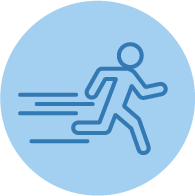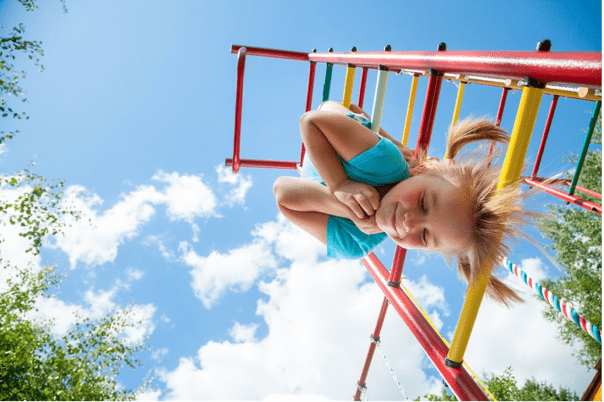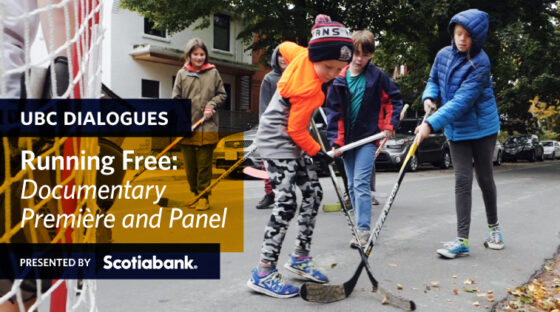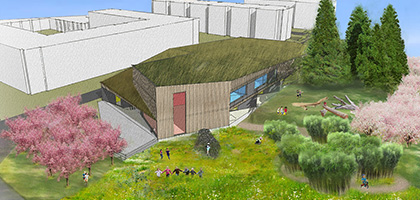OUTDOOR RISKY PLAY

ParticipACTION gave Canadian children a “D” grade for Overall Physical Activity in 2022 and a “D-” for Active Play.1
OVERVIEW
The idea of promoting children’s outdoor risky play may sound counter-intuitive in keeping children safe. However, research suggests that there are important benefits of outdoor risky play for children’s health, development, and well-being. Yet, children’s opportunities have decreased over time, largely due to excessive safety concerns. This trend must be reversed, and it requires a societal shift.
The target is for children and youth to engage in active play and non-organize/structured leisure activities for several hours per day. Boys tend to spend more time playing outdoors than girls, but in general, children of all ages are not meeting these targets.1
BCIRPU Scientist Dr. Mariana Brussoni and her research team have developed an online risk reframing tool to help parents and early childhood educators learn the importance of outdoor risky play and develop strategies for promoting healthy outdoor risky play for children.
To see more research on outdoor risky play, visit the Dr. Brussoni lab website.

Children are more physically active when they are outside doing risky play.2
RESEARCH
Playability (funded by CIHR)
This mixed-methods study aims to better understand physical and socioecological factors that influence children’s outdoor play. Between April 2016 and June 2018, 105 families in three neighbourhoods (Grandview-Woodland, Lower and Central Lonsdale, and Steveston) in Metro Vancouver participated in the study. Various data were collected, including seven days worth of children’s GPS and accelerometry data, qualitative interviews, neighbourhood photos and map drawings, daily diaries, and demographic and other surveys. Dr. Brussoni’s team has published several articles on their research findings and continues to do analyses on the qualitative and quantitative data. These analyses will contribute to informing best practice for design of sustainable and child-friendly urban environments that recognize and include children as active users and meet their needs to positively influence their development and well-being.
Early Childhood Outside! Study (funded by the Government of Canada)
Expanding on the previously developed behaviour change tool to help parents make a plan to support their children’s outdoor risky play, this study’s goal is to develop a risk-reframing tool for early childhood educators. This tool will help early childhood educators learn the importance of outdoor play, reframe perceptions of risk, manage safety fears and guide development of a plan for changing service delivery. Guided by focus group interviews with 40 early childhood educators, students, and licensing officers, the tool will address their needs and concerns in promoting children’s outdoor play at their centre. Included in the tool are six interactive video scenarios (communicating with parents/caregivers, rough and tumble play, play at high speed, play at heights, conflict resolution and play with tools) using a combination of animated characters and props with live action environments. The tool was launched in December 2020.
Early Childhood Outside! Randomized Controlled Trial Study (funded by the Lawson Foundation)
This randomized controlled trial study is to test the efficacy of the risk-reframing tool developed for early childhood educators. This study is recruiting 300 + early childhood educators and/or administrators currently working in Canada.
Eligible participants who agreed to participate will be randomly assigned to one of the two groups: 1) Control group, or, 2) Intervention group, and invited to complete the survey questionnaire at three different timepoints (i.e., baseline, 1–week post–intervention, and 3–months post–intervention). This study is still ongoing.
2019 BC Ministry of Education Play Today Handbook
Dr. Mariana Brussoni’s research on outdoor risky play was cited in the BC Ministry of Education’s 2019 report, Play Today, a guide for BC educators, parents, and families to help facilitate high-quality, play-based learning experiences in children.
City of Vancouver VanPlay Asset Targets

Taking risks outdoors during play can help build risk management skills.2
PREVENTION
If you want to learn more about what outdoor risky play is and how it can benefit children, or to effectively change your behaviour so you can provide children with a positive outdoor risky play experience, visit OutsidePlay.ca. The tool uses a series of interactive video scenarios to help guide you through a personalized journey, where you can reflect on your own childhood, and identify the underlying reasons and motivations for fear. At the end of the tool, it will guide you in creating a personalized plan to help you make changes in your own context that makes sense to you and your child.
RESOURCES
- Injury Insight: Outdoor Schools (PDF) (May 2021)
- Injury Insight: “Kids Bounce Back” After Injury (PDF) (January 2018)
- Injury Insight: Child’s Play: Why it’s Time to Pop the Bubble Wrap (PDF) (February 2015)
- Injury Insight: Is it Safe for Children to Play in Outdoor Spaces? (PDF) (August 2013)
News

Randomized Controlled Trials on the Practice Tool for Early Childhood Educators Begins – Outsideplay.ca
Opportunities for outdoor play have been decreasing due to perceptions that it is dangerous and unnecessary.
Outdoor play during childcare to become more fulfilling for children with $650k gift to UBC Faculty of Medicine
PRO-ECO has four core components that aim to improve early childhood education.

Dr. Brussoni Lab to present Peter Wall Institute for Advanced Studies virtual roundtable series
“Advancing Early Childhood Education Outdoors Now” will take place over three sessions this fall.
New initiatives promote outdoor play among children and youth
A number of new initiatives are now available to improve access to outdoor play in Canada.

Dr. Mariana Brussoni featured in upcoming documentary on children’s independent mobility
alumni UBC is hosting the premiere screening of “Running Free” on Wednesday, September 18.
What does children’s play have to do with roulette?
New research by Tak Ishikawa and Mariana Brussoni looked at parents’ perception of risk after injury.

Proposal submitted for children’s learning play lab
The proposed living lab would be located on the UBC Vancouver campus.
1. ParticipACTION. (2022). The 2022 ParticpACTION report card on physical activity for children & youth. Available at: https://www.participaction.com/wp-content/uploads/2022/10/2022-Children-and-Youth-Report-Card.pdf
2. Brussoni, M., Gibbons, R., Gray, C., Ishikawa, T., Sandseter, E.B.H., Bienenstock, A., Chabot, G., Fuselli, P., Herrington, S., Janssen, I., Pickett, W., Power, M., Stanger, N., Sampson, M., & Tremblay, M.S. (2015). What is the relationship between risky outdoor play and health in children? A systematic review. International Journal of Environmental Research and Public Health, 12 (6), 6423 – 6454. https://doi.org/10.3390/ijerph120606423
